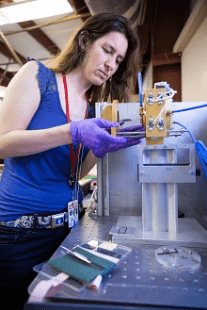Sep 16 2016
The U.S. Department of Energy today announced the launch of the Durable Module Materials National Lab Consortium, or DuraMat, which is designed to accelerate the development and deployment of new, high-performance materials for photovoltaic (PV) modules to lower the cost of electricity generated by solar power while increasing the lifetime of modules in the field. Led by the National Renewable Energy Laboratory (NREL), it includes SLAC National Accelerator Laboratory, Sandia National Laboratories and Lawrence Berkeley National Laboratory, as well as partners from academia and industry.
 Vanessa L. Pool, a postdoctoral researcher at SLAC’s Stanford Synchrotron Radiation Lightsource, with an instrument used to observe how a solar cell’s silver contacts form during high-temperature manufacturing. (Credit: SLAC National Accelerator Laboratory)
Vanessa L. Pool, a postdoctoral researcher at SLAC’s Stanford Synchrotron Radiation Lightsource, with an instrument used to observe how a solar cell’s silver contacts form during high-temperature manufacturing. (Credit: SLAC National Accelerator Laboratory)
SLAC will lead the consortium’s efforts to quickly discover, develop and evaluate new materials for making solar modules cheaper, more efficient and more durable. This effort will focus on accelerating the transfer of new materials and technologies that the consortium develops to industry for commercialization.
“Our work for the consortium will take advantage of our unique capabilities for probing materials with X-rays at SLAC’s Stanford Synchrotron Radiation Lightsource,” a DOE Office of Science User Facility, said Michael Toney, a distinguished staff scientist at SLAC who will lead the consortium’s work in high-throughput materials discovery, characterization and forensics.
“These studies reveal how materials work, at an atom-by-atom level, while a solar cell is operating, and by working with theorists and computer scientists we can greatly accelerate the identification of promising new materials for evaluation,” he said. “We also plan to stress test materials used in today’s solar modules under conditions that simulate decades of wear and tear, so we can find out how and why they fail and learn how to make them last much longer.”
SLAC Chief Technology Officer Mark Hartney, who will lead tech transfer for DuraMat, said, “The goal is to make solar modules last 50 years, so the cost of installing them can be amortized over a much longer time and the levelized cost of the electricity they generate goes down. We have a long history of collaborating with NREL on solar energy materials, including a recent study that looked at how the silver contacts that carry electricity out of the modules form during manufacturing. The aim of our DuraMat research is not only to validate these kinds of new materials and processes, but also to accelerate their acceptance by industry and their inclusion in products.”
The DOE’s SunShot Initiative will provide DuraMat with an estimated $30 million over five years, subject to appropriations.
DuraMat is the fourth consortium established as part of the Energy Materials Network (EMN), which was launched in February by the DOE Office of Energy Efficiency and Renewable Energy (EERE). Crafted to give American entrepreneurs and manufacturers a competitive edge in the global race for clean energy, EMN focuses on tackling one of the major barriers to widespread commercialization of clean energy technologies—the design, testing and production of advanced materials. By strengthening and facilitating industry access to unique scientific and technical resources available for developing advanced materials at the DOE national labs, the network will help industry bring these materials to market more quickly.
Other EMN consortia already in progress are the Lightweight Materials Consortium (LightMat) on lightweight materials for various applications, Electrocatalysis Consortium (ElectroCat) on new catalysts for fuel cells, and Caloric Cooling Consortium (CaloriCool) on refrigerant materials for cooling applications. Three more consortia are anticipated to be announced in fiscal year 2017.
EERE envisions that dramatically accelerating the development of new PV module materials will clear the way for significant reductions in the cost of solar power. It is expected that DuraMat will lead to dependable, high-performance, low-cost PV module materials and architectures by:
Developing module technologies that will enable dramatic reductions in the levelized cost of energy from solar power.
Building a network of active collaborations from within the national laboratories, academia and industry to design, develop and deploy advanced module materials.
Moving highly promising module materials and technologies from early stages of research to successful deployment in the marketplace at an accelerated rate.
Overall, the EMN consortia will form a network of advanced materials R&D capabilities and resources that will support the Administration’s commitment to revitalizing American manufacturing and maintaining a competitive edge in the clean energy economy. This effort supports the President’s Materials Genome Initiative, which has been engaged in work to discover, manufacture and deploy advanced materials twice as fast, at a fraction of the cost. EMN also supports the recommendations of the Advanced Manufacturing Partnership 2.0, a White House-convened working group of leaders from industry, academia and labor, which highlighted the importance of producing advanced materials for technologies critical to U.S. competitiveness in manufacturing.
This article is based in part on a press release issued by EERE.